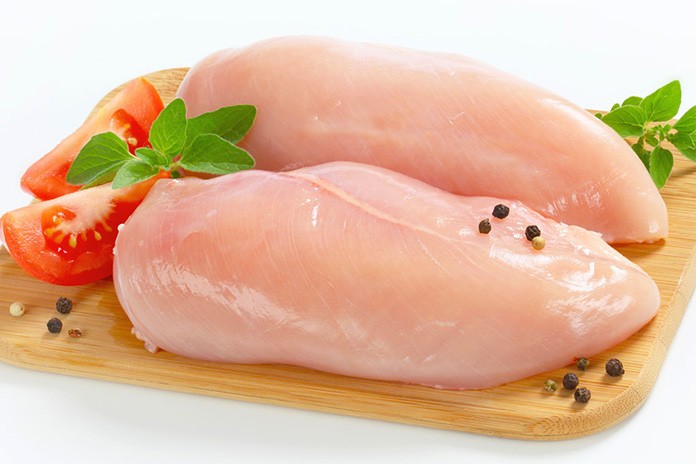
Water holding capacity (WHC) is defined as the ability of meat to hold its inherent and added moisture during fabrication, processing, and storage.
Poor water holding capacity in raw poultry meat results in diminished visual appeal and inferior palatability traits for consumers as well as reduced ingredient retention, protein functionality, and product yields for processors. Broiler breast muscles (Pectoralis major) are comprised of nearly 100% fast-twitch glycolytic muscle fibers making them particularly susceptible to undergoing a rapid postmortem pH decline and exhibiting inferior WHC characteristics. Postmortem muscle pH and protein denaturation are considered the main determinants of WHC in meat. Similar to turkey and pork, poor WHC in chicken meat is often associated with pale lean and low muscle pH. Despite these species similarities, however, the underlying mechanisms that control WHC in pale broiler meat are not well-established. In pork and turkey, low WHC is closely linked to excessive postmortem protein denaturation, particularly that of myosin. While this phenomenon is routinely cited in literature on WHC in chicken, actual data supporting this theory of WHC in chicken are absent or contradictory. Data from an in vitro study suggested that myofibrillar proteins from broiler breast muscles are more resistant to denaturation than similar proteins from pork muscle. Other reports found minimal differences in protein denaturation between pale breast meat and normal or dark colored meat. Furthermore, limited data have been reported on changes in WHC in chicken meat with postmortem time. It has been reported that cook and drip loss increased in broiler breast fillets from 1 to 6 days postmortem, but the mechanism for this increase was not explored. Using a salt-induced water uptake method, it has been observed that WHC is greater at 24 h than at 2 h postmortem in broiler breast meat. Thus, the objectives of the two studies reported here were: 1) to determine the relationship between WHC and protein denaturation in broiler breast meat exhibiting divergent WHC attributes, and 2) to determine changes in WHC and associated physicochemical characteristics in broiler breast meat throughout the first 24 h postmortem.
Experiment 1: Butterfly breast fillets were collected from the deboning line of a commercial broiler processing plant at 2 h postmortem. Fillets were segregated into two groups based on meat pH (spear-tipped probe in cranial end of fillets) and color values (L*a*b*) obtained from the bone-side of the fillets. At 6 and 24 h postmortem samples were collected for WHC and protein denaturation assays. WHC was measured using a salt-induced water uptake assay (swelling/centrifugation method with 0.6 M NaCl), cooking loss, and gravimetric drip loss. Protein solubility measurements (sarcoplasmic and myofibrillar) were used as indicators of protein denaturation. Protein gel electrophoresis and western blot analysis of isolated protein fractions (sarcoplasmic and myofibrillar) were used to quantify the denaturation and 2 translocation of a specific sarcoplasmic protein (glycogen phosphorylase). Data were analyzed as 1-way and 2-way ANOVA’s.
Experiment 2: Eighteen broilers (42 days old) were slaughtered according to standard procedures. Right and left breast fillets were deboned at 30 min postmortem, chilled in an ice slush for 45 min, and then stored at 4°C until 24 h postmortem. Fillets from each carcass were subdivided into three portions which were randomly designated for sampling at 0.75, 2, 4, 8, 12, and 24 h postmortem. At each postmortem time, samples were chopped for 30 sec in a food processor and one portion was used immediately for WHC determination and the remainder was frozen in liquid N2 and stored at -80°C for biochemical measurements. WHC was measured using a salt-induced water uptake assay (swelling/centrifugation method with 0.6 M NaCl). Protein solubility measurements (sarcoplasmic and myofibrillar) were used as indicators of protein denaturation. Meat pH (iodoacetate method), R-value (measure of ATP depletion), sarcomere length, myofibrillar fragmentation index, and myofibrillar protein composition (gel electrophoresis) were also measured. Data were analyzed with postmortem time (fixed effect) and carcass (random effect) included in the mixed model.
Relationship between WHC and protein denaturation (Experiment 1)
Segregating breast fillets by color resulted in sample groups with widely divergent meat quality attributes. Pale fillets exhibited lower pH and higher L* (lightness) values than dark fillets. With respect to WHC, dark fillets exhibited greater salt-induced water uptake and lower cooking loss at both 6 and 24 h postmortem and less drip loss accumulation during refrigerated storage compared to pale fillets. Despite differing in WHC, the overall degree of myofibrillar protein denaturation was not different between pale and dark fillets. Myofibrillar protein solubility was similar between pale and dark fillets at both 6 and 24 h postmortem. These data suggest that myosin denaturation may not be the primary cause of WHC differences between pale and dark broiler breast fillets and support the idea that myosin from chicken breast meat may be resistant to postmortem denaturation. Sarcoplasmic protein solubility was lower in pale fillets than dark fillets at both 6 and 24 h postmortem. Similar differences in sarcoplasmic protein solubility have also been observed between normal and pale broiler breast meat. While overall protein solubility measurements were not strongly correlated to WHC attributes in this study (data not shown), our data suggested that the denaturation of glycogen phosphorylase, a key sarcoplasmic protein involved in glycogenolysis, may be related to WHC. Gel electrophoresis analysis showed that the relative abundance of glycogen phosphorylase in the myofibrillar and sarcoplasmic fractions is strongly correlated to measures of WHC and indicated that there was a greater degree of glycogen phosphorylase denaturation in pale fillets from commercially processed broiler carcasses.
Similarly, it has been reported that glycogen phosphorylase denaturation was associated with high drip loss under experimental conditions in which broiler breast meat was incubated at 40°C for an extended time. Thus, postmortem changes in sarcoplasmic proteins may influence WHC attributes in broiler breast meat.
Effect of post-mortem time on WHC (Experiment 2)
The broiler breast fillets used in this study were considered to be of normal quality based color measurements at 8 h postmortem (L* 56.1±2.5; a* -0.8±0.5; b* 12.3±2.0). Postmortem time was found to have a significant impact on WHC as salt-induced water uptake in the breast meat changed in three distinct phases throughout the first 24 h postmortem. Salt-induced water uptake increased from 0.75 to 2 h, decreased from 2 to 8 h, and gradually increased from 8 to 24 h postmortem. Although postmortem time did not substantially influence the degree of muscle shortening (i.e., sarcomere length) in the deboned breast meat, it strongly influenced the other physicochemical variables. From 0.75 to 8 h postmortem, meat pH decreased and R-value increased. Protein denaturation also changed with postmortem time, as myofibrillar protein solubility decreased from 2 to 4 h and then remained unchanged from 4 to 24 h postmortem while sarcoplasmic protein solubility gradually increased with postmortem time. Gel electrophoresis analysis of the myofibrillar proteins (data not shown) and myofibrillar fragmentation index values indicated that significant aging-related proteolysis occurred in the breast meat from 8 to 24 h postmortem. Correlation analyses indicated that the relationships between WHC and the various physicochemical traits changed with postmortem time. Changes in metabolic traits (pH and R-value) were more closely related to salt-induced water uptake from 2-8 h postmortem while changes in protein denaturation and degradation were more closely related to salt-induced water uptake from 8 to 24 h postmortem. These data demonstrated that WHC in broiler breast meat peaks at 2 to 4 h postmortem and suggested that pH has more influence on WHC during the first 8 h postmortem and protein denaturation has more of an impact on WHC after 8 h postmortem.
These studies demonstrate that WHC in broiler breast meat fluctuates due to underlying structural and biochemical changes occurring in the muscle. During the first 24 h postmortem, the WHC in broiler breast fillets changes in 3 distinct phases. Contrary to what is often assumed, differences in myosin denaturation do not explain variations in WHC in commercially processed broiler breast meat. However, the denaturation of specific sarcoplasmic proteins, such as glycogen phosphorylase, may have a direct impact on WHC in breast meat. Based on these results it is hypothesized that sarcoplasmic proteins denature due to postmortem pH and temperature conditions within the meat and precipitate onto myofilaments which alters protein surface interactions with water and lowers WHC in broiler breast meat. Understanding the dynamic nature of WHC and the controlling factors will provide the foundation necessary for developing effective processing strategies to improve final product quality and yield and for developing rapid, non-invasive techniques for predicting WHC in fresh poultry.
From the Proceedings of the 2016 Midwest Poultry Federation Convention















